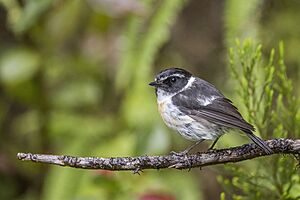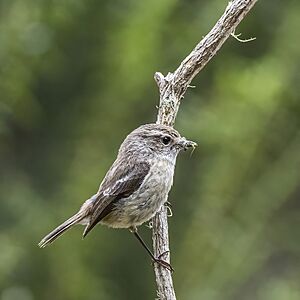Réunion stonechat facts for kids
The Réunion stonechat (Saxicola tectes) is a small, pretty bird that lives only on the island of Réunion. This means it's an endemic species, found nowhere else in the world! You can often spot this little passerine bird in open areas and mountain bushes, even high up to 2600 meters above sea level. It also lives in the plains around the Piton de la Fournaise volcano.
Quick facts for kids Réunion stonechat |
|
|---|---|
 |
|
| male | |
 |
|
| Female both on the slopes of la Roche Écrite |
|
| Conservation status | |
| Scientific classification | |
| Genus: |
Saxicola
|
| Species: |
tectes
|
Contents
About the Réunion Stonechat's Name
The Réunion stonechat was first officially described in 1789. This was done by a German scientist named Johann Friedrich Gmelin. He gave it the scientific name Muscicapa tectes.
Later, in 1802, another German scientist, Johann Matthäus Bechstein, placed it in a new group called Saxicola. This is the group it still belongs to today.
What Does "Saxicola" Mean?
The name Saxicola comes from two Latin words. Saxum means "rock" and incola means "dwelling in." So, Saxicola means "rock-dweller," which fits this bird well!
What Does "Tectes" Mean?
The second part of its scientific name, tectes, sounds like the bird's call! It's a Neo-Latin word that copies the sound "tec-tec." This is also what the bird is called in Réunion Creole, the local language.
Family Tree of the Stonechat
The Réunion stonechat is part of a larger group of birds called the common stonechat family. It's closely related to the Madagascar stonechat. Scientists believe its ancestors came from Africa a very long time ago, about 2 to 2.5 million years ago.
What Does the Réunion Stonechat Look Like?
The Réunion stonechat is easy to recognize! Males and females look a bit different.
Male Réunion Stonechat
The male bird is mostly black on its back and white on its belly. It often has a white stripe above its eye, like an eyebrow. It also has a white half-collar around its neck and a white patch on its wings. You might also see an orange patch on its chest, which can be different sizes.
Female Réunion Stonechat
Female stonechats are a bit different. They are usually browner on their backs and have a more buff (light yellowish-brown) color on their bellies. They often don't have the white patch on their wings that the males do.
How to Tell it Apart
One of the easiest ways to tell the Réunion stonechat apart from its cousin, the African stonechat, is by its head. The Réunion stonechat has a white throat and usually a white stripe above its eye. The African stonechat, however, has a completely black head, including its throat and the area above its eye.


